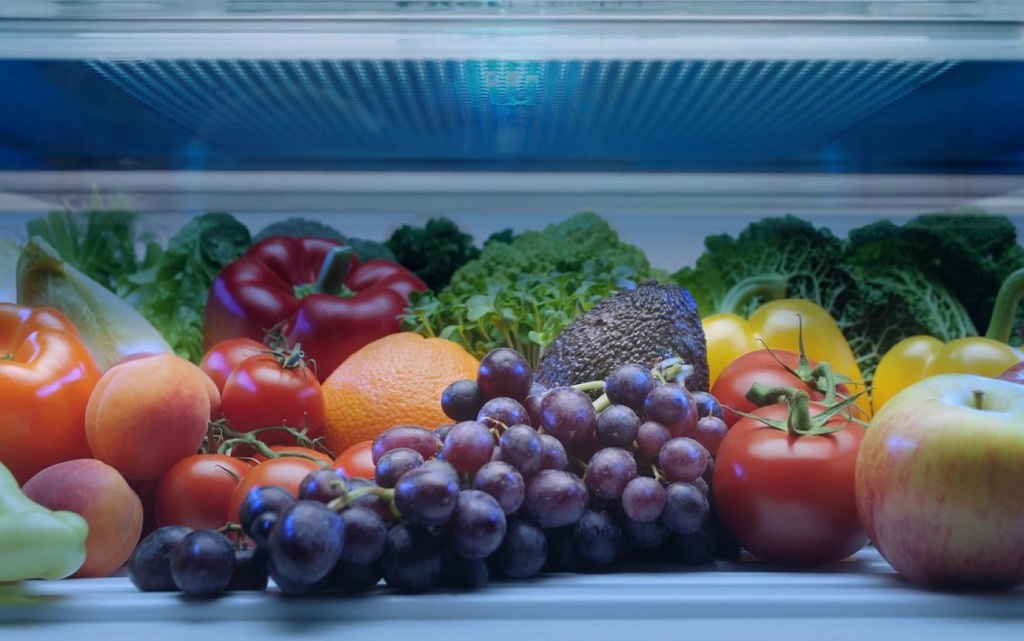One of the top prizes at 2023 KBIS (Kitchen & Bath Industry Show) was awarded to Beko, an appliance brand that recently debuted a refrigerator capable of keeping fruits and vegetables harvest fresh, using technological advancements in the crisper.
Taking a page from nature’s book, Beko uses Red, Green and Blue LED lighting in its HarvestFresh line of refrigerator crispers to simulate the sun’s natural cycle. The LED lights preserve and prolong the nutritional value of fruits and vegetables that have already been harvested, which normally begin to deteriorate once they reach grocery shelves.
Prolonging the life of fruits and vegetables post-harvest represents has been a key goal of modern kitchens. For this article, we investigate the science behind the products for three appliance makers who claim to have proven technology for keeping produce fresher longer, and in some cases, even enhancing their nutritional value, all while in the crisper drawer.
Table of Contents
- The Challenges of Post-Harvest Fruits & Vegetables
- Produce Statistics: The Economics of Waste
- NASA Technology for Produce Preservation: Sub-Zero
- Light Technology for Post-Harvest Freshness: Beko & Mitsubishi
- Health & Wellness Benefits of Beko’s HarvestFresh Technology
Also see:
The Challenges of Post-Harvest Fruits & Vegetables
There’s nothing more aggravating for a home chef than being in the midst of preparing a meal, only to discover that the spinach or lettuce you purchased last week has already started to turn brown and has become inedible. Another challenge is being unable to consume ripe fruit quickly enough before it begins to spoil.
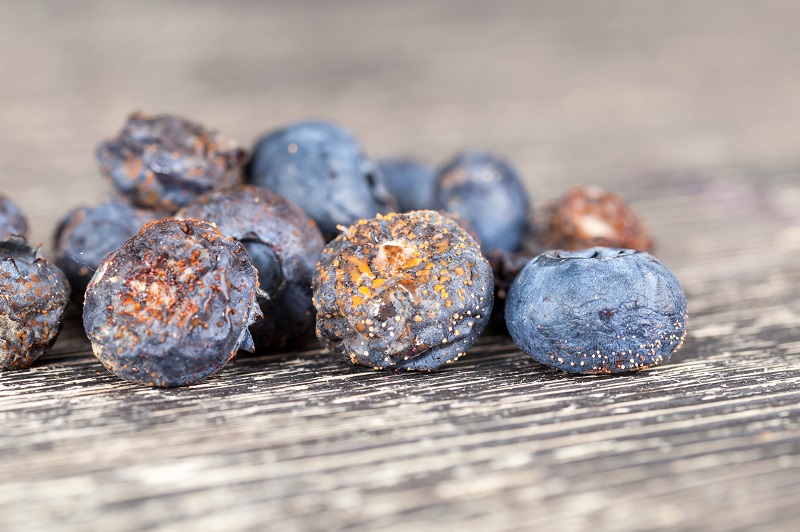
In fact, a recent survey sponsored by Beko, revealed that 88% of 2,000 respondents wished that they could keep their fruits and vegetables fresh for longer periods of time.
Post-harvest preservation of fruits and vegetables is one of the banes of the modern kitchen. Most households prefer to purchase their produce once a week, store them and have them be garden fresh when being prepared for consumption.
“Not so fast!” says Nature.
Many fruits and vegetables emit a natural gas called ethylene which helps ripen produce. Remember how your parents or Home Economics instructors taught you to put apples in a brown paper bag together with an unripe banana or avocado to ripen them faster? Well, that is ethylene gas senescence doing what it does best.
However, most times we want to control the ripening of fruits and vegetables to fit our schedules. In order to combat the quick over-ripening of produce, we purchase under-ripe or green produce with the hope that it will mature on our counter tops or in the refrigerator at an ideal later date.
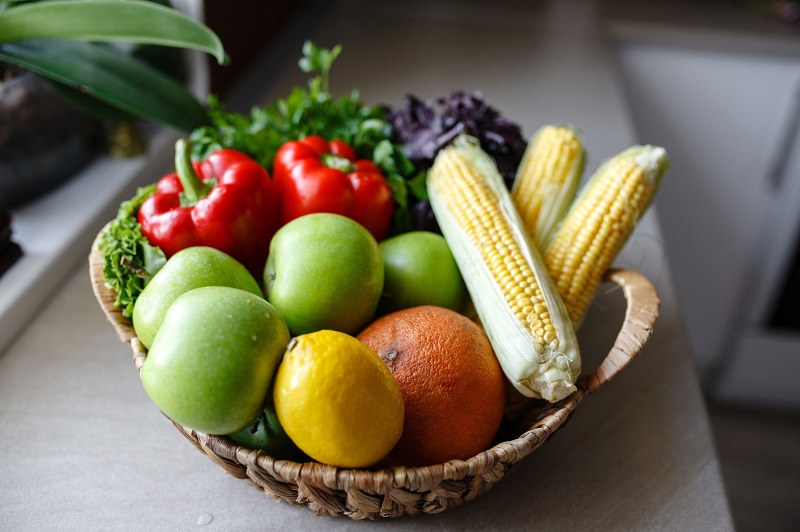
Unfortunately, post-harvest fruits and vegetables that are stored away at home begin to lose their nutritional value and begin a natural chemical degradation process the moment they are picked and packed. In fact, the very instant a fruit is separated from its parent tree or a vegetable is removed from the ground, they begin to deteriorate.
Even if produce ripens naturally on the counter, without the aid of circadian rhythms from the sun, they may result in flavorless, low-nutrient, and disappointing examples of what could have been.
Modern refrigerator technology has taken the next step in continuing on nature’s journey. From ethylene gas control to circadian entrainment, today’s advanced refrigeration technologies are aiming to curtail the “race against the clock” challenge of going from farm to consumption, by preserving freshness and nutritional value.
Produce Statistics: The Economics of Waste
Americans currently waste approximately 80 billion pounds of food each year, mainly due to spoilage, which equates to 219 pounds of food per person. According to the U.S. Department of Agriculture, most discarded foods end up in landfills and comprise the single largest component in US based landfills today.
Once again, modern convenience plays a hand in these troublesome statistics, as Americans tend to be impulsive when purchasing food, which is in great supply relative to other parts of the world.
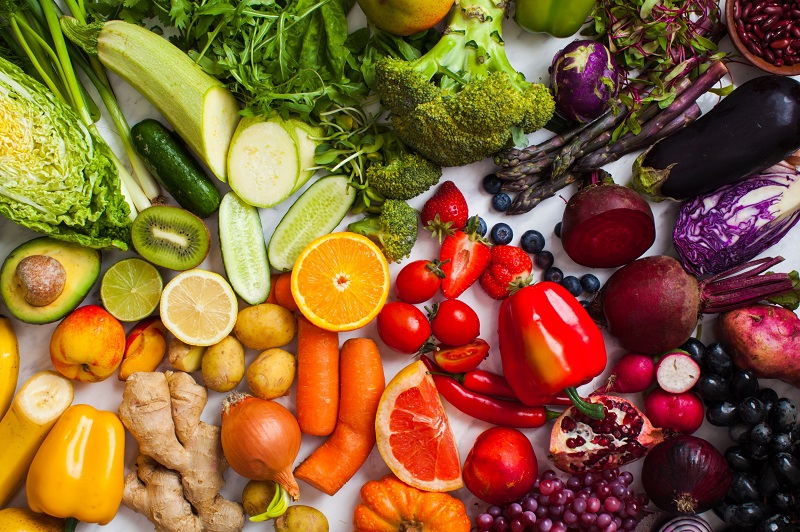
US consumers often find themselves buying more food than needed, especially produce, and eventually end up discarding approximately $1,600 a year of fruits and vegetables per household.
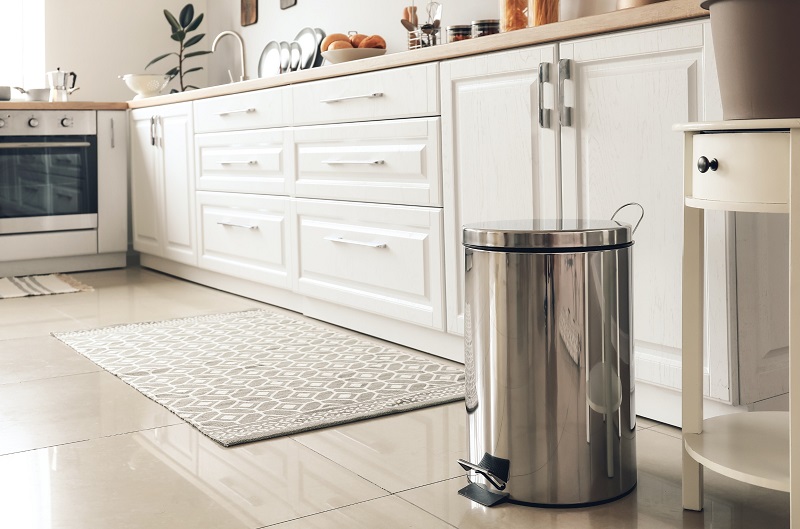
The idea of preserving produce in the refrigerator is not new, as appliance manufacturers, such as Sub-Zero and Mitsubishi, have touted their products’ abilities to do just that, albeit Sub-Zero uses a different concept and technology.
NASA Technology for Produce Preservation: Sub-Zero
Sub-Zero refrigerators come with an anti-microbial air purification system (based on technology developed by NASA) that scrubs the air of ethylene gas (the “ripening gas”), every 20 minutes.
Since ethylene gas is a natural byproduct of many vegetables, especially apples, it’s a good idea to keep ethylene-producing fruit away from ethylene-sensitive produce to prevent fast ripening and spoilage. However, if you insist on placing all fruits and vegetable in your refrigerator, then you may want to invest in a Sub-Zero.
Sub-Zero also has the proud distinction of being the pioneer of the dual compressor fridge which has separate units for both the refrigerator and the freezer due to their different environmental requirements.
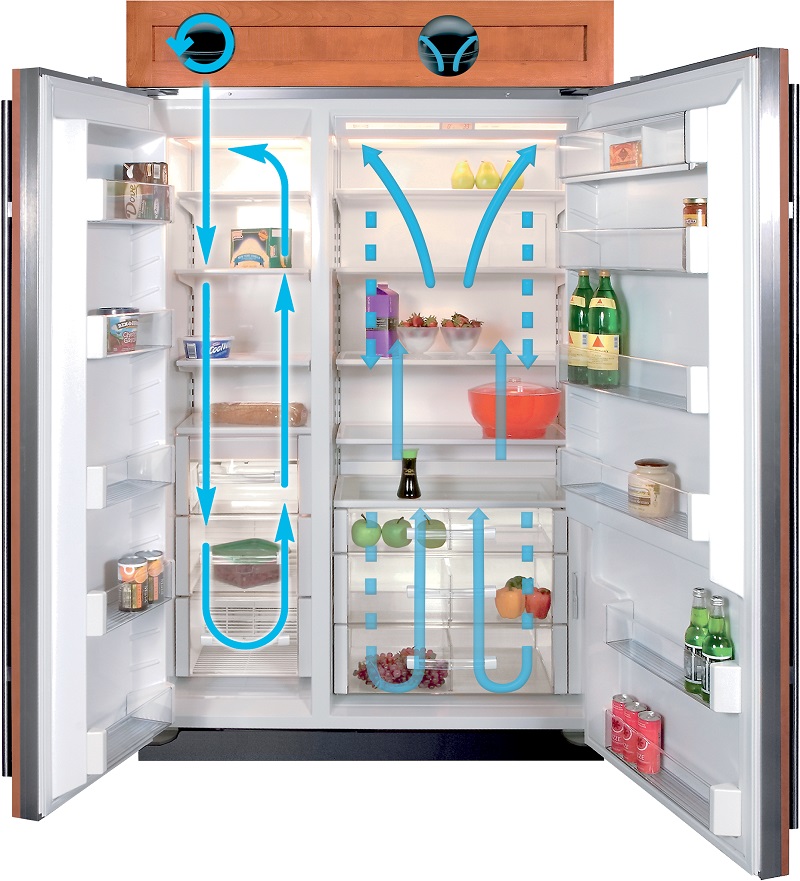
Image courtesy of Sub-Zero
Freezers require that compartment air be frigid and dry. Refrigerators, on the other hand, need a warmer temperature (34-38 F) with optimal humidity to maintain foods at peak freshness and flavor, and to stave off harmful microbes.
Tight seals on all of Sub-Zero doors also ensure that temperatures within both the freezer and refrigerator compartments are controlled with precision. Ambient air from the kitchen, especially on warmer days, can cause fluctuations to interior temperatures, but the Sub-Zero microprocessor maintains the compartmental temperatures with utmost precision to allow foods to last longer.
Light Technology for Post-Harvest Freshness: Beko & Mitsubishi
Cell biology technology, which has long been the subject of many a scientific paper, has finally made its way to the consumer appliance market. Post-Harvest Circadian Entrainment is the term used for understanding and training fruits and vegetables after they have been picked from the vine, tree, or dug up from the earth.
Mitsubishi and the Folio Line
Back in 2018, Mitsubishi introduced its Folio line of refrigerators with Vitamin Factory, capable of generating simulated daily cycles of sunlight using LED light with varying wavelengths of red, blue and green spectrums.
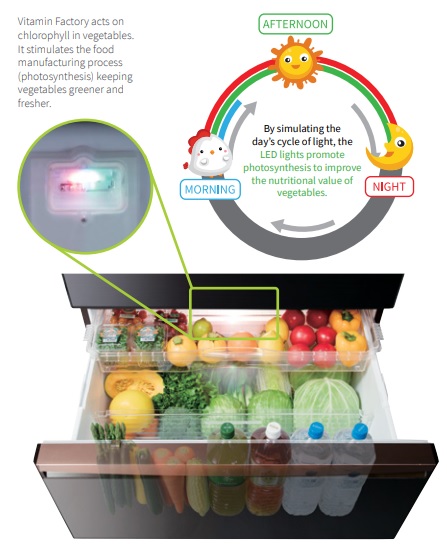
Image courtesy of Mitsubishi Electric
The goal is to allow vegetables to continue to perform photosynthesis post-harvest, which allows them to stay fresh longer while resting in a refrigerator crisper drawer. This concept is known as “post-harvest circadian entrainment”, and is a proven phenomenon that has been studied by cell biologists for years.
According to Mitsubishi:
“Chlorophyll in fruits and vegetables remains in an active state, resulting in an increase of Vitamin C which keeps vegetables fresh and crisp. The orange LED light used in the Hybrid series can increase Vitamin C by up to 18% while the 3-colour LED lights in the Folio series can raise it by up to 22%.”
Additionally, scientists have demonstrated that post-harvest circadian entrainment can also promote pest resistance from herbivores or plant-eating pests, while also improving their anti-cancer properties.
Beko HarvestFresh Technology
In 2023, Beko, a European brand of sustainable appliances for consumers, introduced its HarvestFresh technology, which also uses LED technology to simulate the sun’s natural daily cycle as it rises, reaches its apex, and then sets at dusk. Beko’s tri-color technology simulates the full spectrum of the sun’s natural cycle.
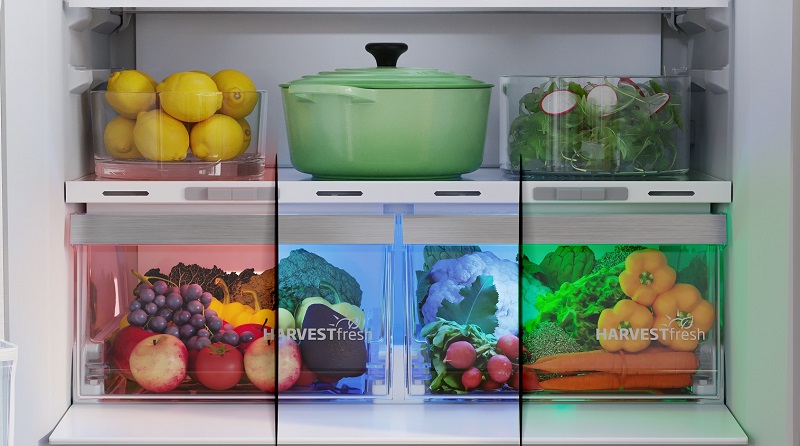
Edited image to demonstrate the three colors of Beko’s Circadian Entrainment Cycle
The idea is to foster circadian entrainment of fruits and vegetables as they sit in your crisper drawer while enhancing their nutritional value and flavor.
New HarvestFresh Refrigerators by Beko
Beko’s Circadian Entrainment Cycle
- First 4 Hours of Daylight: Blue Light
- Next 2 Hours of Daylight: Green Light
- Next 6 Hours of Daylight: Red Light
First 4 Hours of Daylight: Blue Light
During the first four hours of the day, Beko’s blue spectrum mimics dawn or the day’s first light. Similar to the light of dawn in the sun’s natural light cycle, the blue spectrum represents the coolest light similar to natural early dawn.
Next 2 Hours of Daylight: Green Light
The next two hours see the crisper bathed in green light which replicates the hottest part of the sun’s daily cycle during midday and the cycle of photosynthesis.
Next 6 Hours of Daylight: Red Light
The next six hours are bathed in red light, simulating the muted tones of dusk as it slowly merges into nightfall.
It’s important to note that Beko’s HarvestFresh line of refrigerators have crispers that have their lights on during their simulated sun cycles.
Unlike regular refrigerators, HarvestFresh crisper lights run their spectrum sequences with only a 12-hour darkness period each day. The lights illuminate in a timed sequence, so they are not necessarily attuned to the sun’s actual cycle outdoors.
Health & Wellness Benefits of Beko’ HarvestFresh Technology
Beko’s HarvestFresh technology preserves the vitamins of produce that has been harvested, and has not been allowed to reach its full nutritional potential. In many cases, HarvestFresh keeps produce fresher longer than an average refrigerator, due to controlled temperature and humidity in crisper drawers.
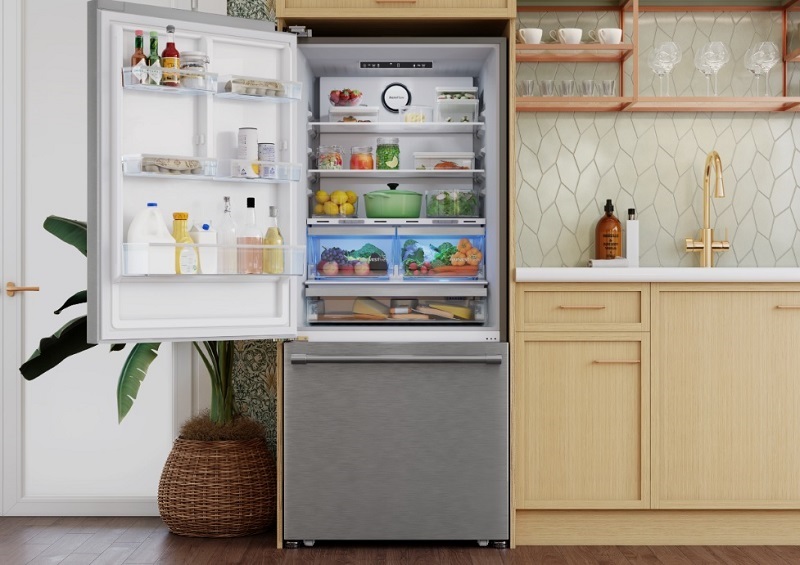
This was verified by independent tests that measured Vitamins C and A in tomatoes, green peppers, carrots, spinach and celery directly exposed to Beko’s light technology over a 5 day period. The technology is akin to harvesting vine- or tree-ripened produce from your refrigerator.
Having tastier fruits and vegetables, available at the peak of freshness, should also encourage more produce consumption for a healthier diet.
More Kitchen & Wellness Articles
- Steal These 10 Great Ideas for an Epic Kitchen Reorganization
- Teas from Around the World that Provide 5 Powerful Health Benefits
- Signs That It’s Time to Replace Your Kitchen Cabinetry
- Increase Your Home’s Energy Efficiency with Daylight Harvesting
- Best Cooking & Food Shows on Netflix Right Now
- Best Baking Shows on Netflix Right Now
- Best Cooking & Food Shows on Hulu Right Now
- Best Cooking & Food Shows on Amazon Prime Right Now
- If You Love Free Cooking Shows, You’ll Love the Roku Channel!
- Best International Cooking Channels on YouTube
- Best Cooking & Food Shows Available to Stream on PBS
- 15 Great Culinary Movies to Enjoy, Study and Savor
- 10 Inspirational Food Documentaries on Hulu
| Purgula is reader-supported. When you click on links to other sites from our website, we may earn affiliate commissions, at no cost to you. If you find our content to be helpful, this is an easy way for you to support our mission. Thanks! Learn more. |

